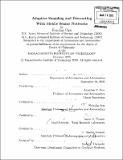Adaptive sampling and forecasting with mobile sensor networks
Author(s)
Choi, Han-Lim
DownloadFull printable version (24.32Mb)
Other Contributors
Massachusetts Institute of Technology. Dept. of Aeronautics and Astronautics.
Advisor
Jonathan P. How.
Terms of use
Metadata
Show full item recordAbstract
This thesis addresses planning of mobile sensor networks to extract the best information possible out of the environment to improve the (ensemble) forecast at some verification region in the future. To define the information reward associated with sensing paths, the mutual information is adopted to represent the influence of the measurement actions on the reduction of the uncertainty in the verification variables. The sensor networks planning problems are posed in both discrete and continuous time/space, each of which represents a different level of abstraction of the decision space. In the discrete setting, the targeting problem is formulated to determine the sequence of information-rich waypoints for mobile sensors. A backward formulation is developed to efficiently quantify the information rewards in this combinatorial decision process. This approach computes the reward of each possible sensing choice by propagating the information backwards from the verification time/space to the search space/time. It is shown that this backward method provides an equivalent solution to a standard forward approach, while only requiring the calculation of a single covariance update. This work proves that the backward approach works significantly faster than the forward approach for the ensemble-based representation. In the continuous setting, the motion planning problem that finds the best steering commands of the sensor platforms is posed. The main difficulty in this continuous decision lies in the quantification the mutual information between the future verification variables and a continuous history of the measurement. (cont.) This work proposes the smoother form of the mutual information inspired by the conditional independence relations, and demonstrates its advantages over a simple extension of the state-of-the-art: (a) it does not require integration of differential equations for long time intervals, (b) it allows for the calculation of accumulated information on-the-fly, and (c) it provides a legitimate information potential field combined with spatial interpolation techniques. The primary benefits of the presented methods are confirmed with numerical experiments using the Lorenz-2003 idealistic chaos model.
Description
Thesis (Ph. D.)--Massachusetts Institute of Technology, Dept. of Aeronautics and Astronautics, 2009. Includes bibliographical references (p. 213-219).
Date issued
2009Department
Massachusetts Institute of Technology. Department of Aeronautics and AstronauticsPublisher
Massachusetts Institute of Technology
Keywords
Aeronautics and Astronautics.